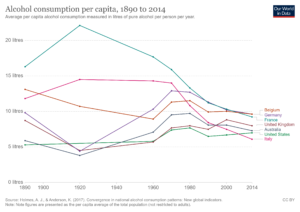May 12, 2021. Exactly two months ago I quit drinking (alcohol, if it needs to be specified). More on my decision to quit drinking and how I went about doing it (after listening to Annie Grace in a podcast,...
 May 12, 2021. Exactly two months ago I quit drinking (alcohol, if it needs to be specified). More on my decision to quit drinking and how I went about doing it (after listening to Annie Grace in a podcast, and reading her book, This Naked Mind)will be grist for my next post. Here I’ll summarize my attempts to research alcohol consumption in the US, especially by boomers.
May 12, 2021. Exactly two months ago I quit drinking (alcohol, if it needs to be specified). More on my decision to quit drinking and how I went about doing it (after listening to Annie Grace in a podcast, and reading her book, This Naked Mind)will be grist for my next post. Here I’ll summarize my attempts to research alcohol consumption in the US, especially by boomers.
I wanted to find out if my drinking put me in a lonely class of boomers who drink too much. It turns out I was not the only Baby Boomer who was consuming too much alcohol too frequently–who was suffering, in other words, from Alcohol Use Disorder (AUD). [I note at the outset that many of the following statistics result from self-reporting of alcohol consumption. Knowing how untruthfully I answered questions about drinking for years, I am suspicious of researchers’ abilities to correct for false reporting.]
I came up with a mixed bag of often confusing statistics. Average per capita alcohol consumption in the United States, measured in liters of pure alcohol per person per year, is generally lower than many developed countries. It grew to 7.7 liters a year(a little over 2 gallons) in 1980 (roughly half that in France or Italy, for example). Then it declined about 10 % over the next 35 years.
 Alcohol consumption in selected countries.
Alcohol consumption in selected countries.
More recently, according to a study by the National Institute on Alcohol Abuse and Alcoholism (NIAAA), consumption began to rise noticeably in the US—increasing by 8 percent between 1999 and 2017. The upward trend was particularly noticeable among women. The proportion of men who reported they consumed alcohol over the period was relatively flat, while the proportion of women who did so increased by 10 percent. The trend in binge drinking (5 drinks in 2 hours for men, 4 drinks for women) is even worse, with a 23 percent increase in binge drinking among American women.
Notably, these increases were observed before the pandemic, during which the International Journal of Environmental Research and Public Health found that of the more than 800 respondents — those who replied to the online questionnaire were mostly white women — 60 percent were drinking more compared with before Covid-1.
More encouraging than the recent uptick in overall drinking, and the larger increase in women’s drinking, is the dramatic decrease in drinking among the very young. Between 2002 and 2019, one study found the use of alcohol in the past month was down nearly half among 12-17 year-olds.
Of particular interest to me is the data on the increased consumption of alcohol among baby boomers, where the increase in binge-drinking elders is particularly noticeable. Lest you say this must be a particularly downtrodden group of elderly miscreants, the NIAAA says the increase in drinking among elderly Americans is most pronounced among people with greater levels of education and income, and among women. On a steady rise in recent years, more than 15% of we boomers now fit the category of binge drinkers. In fact, it turns out according to UCLA Professor Dr. Alison Moore that about 10-15 percent of people don’t start to drink heavily until they are older in age.
Furthermore, Baby Boomer bingeing, even episodically or infrequently, is particularly dangerous. AUD seriously affects other health conditions in the elderly by exacerbating disease, interacting with prescribed medications, and complicating disease management. Furthermore, over time the body builds up a tolerance to alcohol, and as a result it takes more and more alcohol for a boomer to reach the “desired” effect. Compounding the dangers of elderly drinking, the body’s tolerance for alcohol declines as we age. Boomers generally experience the effects of alcohol more quickly than when they were younger, putting us at higher risks for falls, car crashes and other injuries and accidental death.
Finally, the accumulation of years of alcohol abuse can greatly exacerbate the risks of many health issues that you are already at risk of contracting simply due to age: type 2 diabetes, high blood pressure (that in turn can lead to kidney failure, heart attacks and strokes, decreased libido, heart failure). We all know excessive drinking also leads to cirrhosis of the liver and other liver failure, but it also contributes to osteoporosis, memory problems, and mood  disorders.
disorders.
Overall, the social cost of all this drinking, is huge, although it’s hard to find a current estimate of that cost. The most recent data I could find was from 2010, when the CDC estimated the cost of excessive alcohol use in the United States is well over $250 billion, mostly due to binge drinking. Applying even a modest cost-of-living increase to that figure would place it currently at some $350 billion. The loss of lives from alcohol-related causes was estimated in 2010 to 95,000 people (68,000 men and 27,000 women). Only tobacco and poor diet and physical inactivity are estimated to kill more Americans annually.
Bottom line is I am far from alone in having succumbed to a life-style of drinking too much, too often. And that club of Boomer Bingers is growing. So exactly two months ago, I quit! I’ll explain how and why in my next post.


